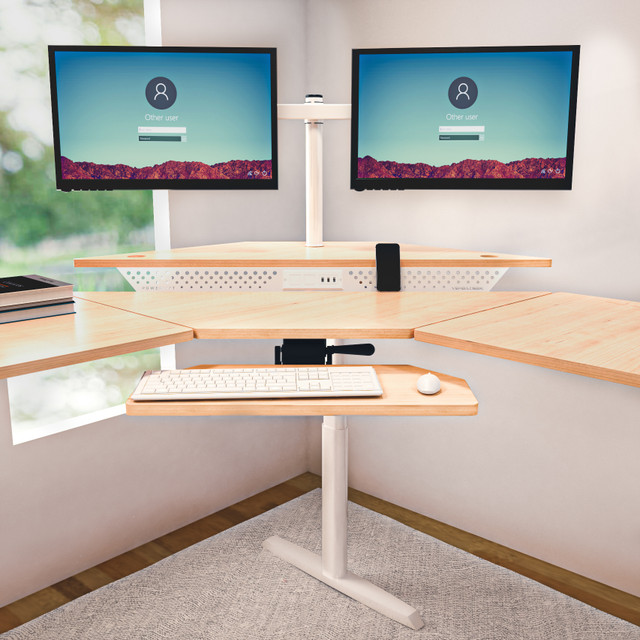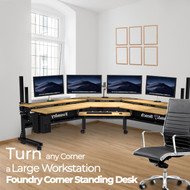Are Standing Desks Good for Kids? Unveiling the Surprising Benefits
Posted by Anthony Taneo on Jan 12th 2024
Are Standing Desks Good for Kids? Unveiling the Surprising Benefits
As parents and educators, we constantly seek ways to enhance our children's learning environments, prioritizing their comfort and health. Recently, the spotlight has turned to standing desks, a trend gaining ground in the adult workspace. But what about kids? Are standing desks like the popular Versa Desk beneficial for our younger generation?
In this blog, we'll explore the potential advantages of standing desks for kids, debunk common myths, and offer insights into making the transition as smooth as possible.
The Rising Popularity of Standing Desks
Standing desks, also known as riser desks or desk raisers, have revolutionized the concept of a traditional workspace. Initially seen as a niche product, they've become increasingly mainstream thanks to their health and productivity benefits. Companies like Versa Desk are at the forefront, offering a range of standing desks that cater to various needs.
Why Consider a Standing Desk for Your Child?
Health Benefits: The most touted benefit of standing desks is their health advantage. A desk riser promotes better posture and reduces the risk of obesity and associated diseases. By using a standing desk, children can avoid the pitfalls of prolonged sitting, which include poor circulation and muscle degeneration.
Enhanced Focus and Productivity: Evidence suggests that standing desks can boost focus and productivity. Children using standing desks are often more engaged and less prone to distractions. This is particularly beneficial for kids with attention-deficit/hyperactivity disorder (ADHD), as standing helps them expend excess energy productively.
Flexibility and Adaptability: Desk risers and desk raisers offer flexibility. Kids can adjust their desks to alternate between sitting and standing, promoting daily movement and variety. This adaptability is critical in creating a dynamic learning environment that caters to different activities and needs.

Addressing the Myths
Myth 1: "Standing All Day is Just as Bad as Sitting All Day"
It's essential to strike a balance. The goal of a standing desk, especially models like those from Versa Desk, isn't to replace sitting with standing entirely. Instead, it's about movement and variability. Alternating between sitting and standing can be the best strategy.
Myth 2: "Standing Desks Are Not Suitable for Young Kids"
Many assume that standing desks are designed for adults and older children. However, even young kids can enjoy the benefits of adjustable desk risers. These desks grow with your child, ensuring a good fit through all stages of development.
Making the Transition to a Standing Desk
Start Slowly: If your child is used to sitting at a desk, a sudden switch to standing can be challenging. Begin with short periods of standing and gradually increase the duration.
Ensure Proper Ergonomics: The standing desk height should be adjusted so that your child's arms can rest comfortably on the surface without hunching over. Versa Desk offers a range of height-adjustable desks that can be fine-tuned for the perfect fit.
Encourage Regular Movement: Standing still for long periods can also be tiring. Encourage your child to move around, stretch, or even do light exercises while standing.
Create a Conducive Environment: Place the standing desk in a well-lit, comfortable, distraction-free area. Ensure the floor is cozy, adding an anti-fatigue mat for extra comfort.
Versa Desk: A Case Study in Innovation
Versa Desk stands out as a pioneer in the world of standing desks. Their desks are not just about standing; they encourage a more active and health-conscious lifestyle. Versa Desk products offer kids a fun and interactive way to learn and grow. The ease of adjusting the height means that the desk adapts to your child's needs, whether they're reading, writing, or engaged in creative activities.
Integrating Standing Desks into Daily Routines
Making a standing desk a part of your child's daily routine requires a thoughtful approach. It's not just about placing a desk riser in their room; it's about creating a habit. Please encourage your child to use their standing desk for activities like homework or drawing. This way, the standing desk becomes a natural part of their day-to-day life.
Involving Kids in the Choice
Involvement in the decision-making process can make kids more excited about their standing desk. Let them choose from the range of Versa Desk options or allow them to personalize their desk space. This sense of ownership can make transitioning to a standing desk more appealing and fun.
Educational Institutions Taking Note
The benefits of standing desks are not limited to the home environment. Progressive schools are beginning to integrate desk risers and standing desks into classrooms. This shift is a testament to the growing recognition of the importance of physical health in educational settings. Schools can cater to different learning styles and physical needs by providing a mix of sitting and standing options.
Supporting Research
Numerous studies support the benefits of standing desks for children. For instance, research has shown that students using standing desks demonstrate increased engagement and better academic performance. This is particularly significant in subjects requiring high concentration levels, like mathematics and science.
Parental and Teacher Roles
Parents and teachers play a crucial role in making the shift to standing desks successful. It's essential to guide and monitor children to ensure they use their desks correctly. This includes checking their posture and the desk's height and ensuring they take breaks to sit and relax.
Long-Term Implications
The long-term implications of using standing desks go beyond physical health. They instil a mindset of wellness and active living from a young age. This can profoundly affect children's attitudes towards health and fitness as adults.
Addressing Concerns
Some parents may have concerns about the cost of standing desks like those from Versa Desk. Viewing this as an investment in your child's health and educational experience is essential. Moreover, the durability and adjustability of these desks mean they can be used for many years, offering real value over time.
A Step Towards a Healthier Future
In conclusion, exceptionally versatile and kid-friendly standing desks like those from Versa Desk offer many benefits for children. The advantages are clear, from promoting better physical health to enhancing focus and study engagement.
As we navigate the challenges of modern education and child-rearing, incorporating elements that contribute to a healthier, more active lifestyle is crucial. Standing desks for kids are not just a fad; they are a step towards a more dynamic and health-conscious future for our children.
By embracing this trend and integrating it thoughtfully into our children's lives, we are setting them up for success - academically, their overall well-being, and their approach to life. Let's stand up for our children's health and give them the foundation they need to thrive in all aspects of their lives.
Final Thoughts
The shift towards dynamic and flexible learning environments is underway, and standing desks are a significant part of this movement. By incorporating a standing desk like those offered by Versa Desk into your child's study area, you're investing not just in furniture but in their health, well-being, and academic success.
As we continue to explore and understand the needs of our children in a rapidly changing world, it's clear that standing desks are more than just a trend. They're a step towards a more active, healthy, and engaged way of learning. So, are standing desks good for kids? The answer is a resounding yes, with the caveat of balance and proper use. Let's embrace this innovation and watch our children stand tall and thrive.

